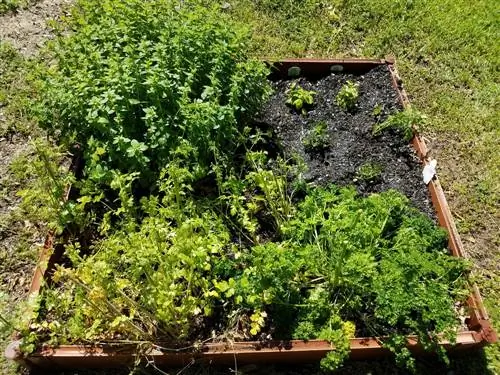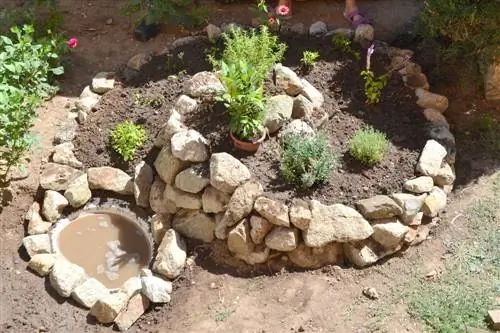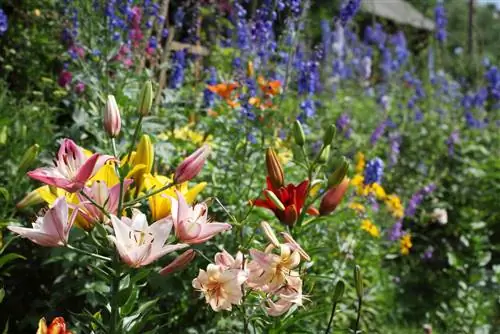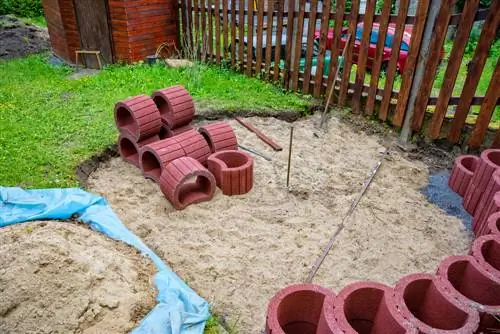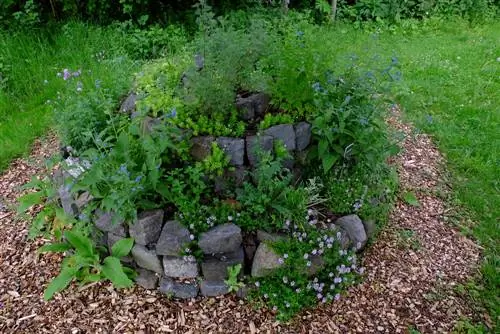- Author admin [email protected].
- Public 2023-12-16 16:46.
- Last modified 2025-01-23 11:21.
A herb spiral or herb snail allows you to grow a wide variety of garden herbs in just a few square meters. The location requirements of the different species are taken into account; with a sophisticated planting plan you can harvest fresh herbs all year round.
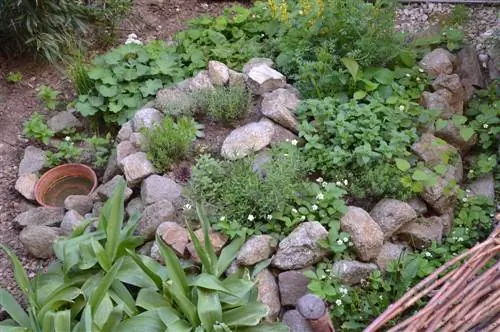
How do I create a herbal spiral?
To create a herb spiral, you need a 25 cm thick layer of gravel and gravel, followed by a cone-shaped pile and graduated substrates. Plant perennial herbs in spring and annual herbs after the ice saints, pay attention to suitable location requirements and crop rotation.
The structure of the herb snail
Generally, a herb snail is built from stone, but you can also build it from wood or other materials. What is particularly important is the internal structure: at the bottom there is a layer of gravel and gravel about 25 centimeters thick, which forms the foundation of the spiral and also serves as drainage. In the middle there is a cone-shaped pile of building rubble / gravel / gravel, which should measure between 80 and 100 centimeters to the top. First fill with a layer of sand, followed by the different substrates. The further up in the herb spiral they are filled, the leaner and more sandy they are.
The most favorable planting time
The best time to plant perennial herbs is early spring. Hardy species can also be released in the fall. First place the herbs with the pots in their designated places on the spiral. This way you can check the individual locations and the distances again. Then dig a hole at a time with a shovel, embed the root ball in it and fill the hole back up. Then press the soil carefully with your hands and water the plant well with plenty of water. The plants should not be deeper in the ground than before in the pot. You can either plant one- and two-year-old herbs on the windowsill or sow them directly into the spiral after the ice saints. However, when growing annual herbs, you should follow a certain crop rotation because not all species get along with each other. For example, chervil and caraway as well as peppermint and chamomile are bad neighbors.
The ideal planting plan
The following table lists the most important herbs with their botanical names, their heights and their respective location requirements.
| Name | Botanical name | Growth height | Location and soil | Location on the herb spiral | Annual / Perennial |
|---|---|---|---|---|---|
| Aniseed | Pimpinella anisum | 50 to 80 cm | sandy, dry, sunny, chalky | upper area | annual |
| Savory | Satureja hortensis | 20 to 30 cm | sunny, dry | upper area | annual |
| Curry herb | Helichrysum italicum | 20 to 45 cm | sunny, dry | upper area | perennial |
| Dill | Anethum graveolens | 30 to 100 cm | sunny, rather humid | middle to lower area | annual |
| Tarragon | Artemisia dracunculus | 60 to 120 cm | sunny, sheltered | middle area | perennial |
| St. John's Wort | Hypericum perforatum | 40 to 100 cm | dry, sunny to partially shaded | middle area | perennial |
| Chervil | Anthriscus cerefolium | 30 to 70 cm | partly shaded, rather moist | lower area | annual |
| garlic | Allium sativum | 30cm | sunny, dry, profound | upper area | annual |
| Lavender | Lavandula angustifolia | 30 to 60 cm | sunny, dry, chalky | upper area | perennial |
| Marjoram | Origanum majorana | 60cm | sandy, humus | mid to upper range | annual |
| Oregano | Origanum vulgare | 50 to 70 cm | sunny to partially shaded | mid to upper range | perennial |
| parsley | Petroselinum crispum | 20 to 30 cm | humic, moist, partially shaded | lower area | two-year-old |
| Peppermint | Mentha piperita | 30 to 60 cm | moist, humus, sunny to partially shaded | lowest area | perennial |
| Sage | Salvia officinalis | 30 to 70 cm | sunny to partially shaded, dry, chalky | top area | perennial |
| Chives | Allium schoenoprasum | 20 to 30 cm | sandy, moist, sunny to partially shaded | lowest area | perennial |
Tip
Choose small-growing varieties so that the spiral doesn't immediately overgrow and you don't have to constantly cut the plants back. Large giants such as lovage, in particular, should be placed next to the spiral where they can spread out. The same applies to large herbs with long roots such as comfrey or horseradish.


